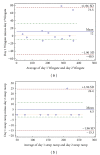Test-Retest Reliability and Physiological Responses Associated with the Steep Ramp Anaerobic Test in Patients with COPD
- PMID: 22720154
- PMCID: PMC3375098
- DOI: 10.1155/2012/653831
Test-Retest Reliability and Physiological Responses Associated with the Steep Ramp Anaerobic Test in Patients with COPD
Abstract
The Steep Ramp Anaerobic Test (SRAT) was developed as a clinical test of anaerobic leg muscle function for use in determining anaerobic power and in prescribing high-intensity interval exercise in patients with chronic heart failure and Chronic Obstructive Pulmonary Disease (COPD); however, neither the test-retest reliability nor the physiological qualities of this test have been reported. We therefore, assessed test-retest reliability of the SRAT and the physiological characteristics associated with the test in patients with COPD. 11 COPD patients (mean FEV(1) 43% predicted) performed a cardiopulmonary exercise test (CPET) on Day 1, and an SRAT and a 30-second Wingate anaerobic test (WAT) on each of Days 2 and 3. The SRAT showed a high degree of test-retest reliability (ICC = 0.99; CV = 3.8%, and bias 4.5 W, error -15.3-24.4 W). Power output on the SRAT was 157 W compared to 66 W on the CPET and 231 W on the WAT. Despite the differences in workload, patients exhibited similar metabolic and ventilatory responses between the three tests. Measures of ventilatory constraint correlated more strongly with the CPET than the WAT; however, physiological variables correlated more strongly with the WAT. The SRAT is a highly reliable test that better reflects physiological performance on a WAT power test despite a similar level of ventilatory constraint compared to CPET.
Figures


Similar articles
-
Associations between isokinetic muscle strength, high-level functional performance, and physiological parameters in patients with chronic obstructive pulmonary disease.Int J Chron Obstruct Pulmon Dis. 2012;7:537-42. doi: 10.2147/COPD.S34170. Epub 2012 Aug 22. Int J Chron Obstruct Pulmon Dis. 2012. PMID: 22973094 Free PMC article. Clinical Trial.
-
Test-retest reliability of cardiopulmonary exercise test-derived metrics in individuals with COPD versus healthy controls.Clin Physiol Funct Imaging. 2025 Jan;45(1):e12927. doi: 10.1111/cpf.12927. Clin Physiol Funct Imaging. 2025. PMID: 39878361 Free PMC article.
-
Optimal protocol selection for cardiopulmonary exercise testing in severe COPD.Chest. 2007 Nov;132(5):1500-5. doi: 10.1378/chest.07-0732. Epub 2007 Oct 9. Chest. 2007. PMID: 17925427
-
The impact of exercise training intensity on change in physiological function in patients with chronic obstructive pulmonary disease.Sports Med. 2006;36(4):307-25. doi: 10.2165/00007256-200636040-00003. Sports Med. 2006. PMID: 16573357 Review.
-
The Role of Cardiopulmonary Exercise Testing (CPET) in Pulmonary Rehabilitation (PR) of Chronic Obstructive Pulmonary Disease (COPD) Patients.COPD. 2018 Dec;15(6):621-631. doi: 10.1080/15412555.2018.1550476. Epub 2018 Dec 30. COPD. 2018. PMID: 30595047 Review.
Cited by
-
Extended steep ramp test normative values for 19-24-year-old healthy active young adults.Eur J Appl Physiol. 2020 Jan;120(1):107-115. doi: 10.1007/s00421-019-04255-x. Epub 2019 Nov 8. Eur J Appl Physiol. 2020. PMID: 31705276 Free PMC article.
-
Metabolic Flexibility and Mechanical Efficiency in Women Over-60.Front Physiol. 2022 Apr 6;13:869534. doi: 10.3389/fphys.2022.869534. eCollection 2022. Front Physiol. 2022. PMID: 35464093 Free PMC article.
-
Functional Status Assessment of Patients With COPD: A Systematic Review of Performance-Based Measures and Patient-Reported Measures.Medicine (Baltimore). 2016 May;95(20):e3672. doi: 10.1097/MD.0000000000003672. Medicine (Baltimore). 2016. PMID: 27196472 Free PMC article.
-
Feasibility of an Outpatient Training Program after COVID-19.Int J Environ Res Public Health. 2021 Apr 9;18(8):3978. doi: 10.3390/ijerph18083978. Int J Environ Res Public Health. 2021. PMID: 33918887 Free PMC article.
-
Associations between isokinetic muscle strength, high-level functional performance, and physiological parameters in patients with chronic obstructive pulmonary disease.Int J Chron Obstruct Pulmon Dis. 2012;7:537-42. doi: 10.2147/COPD.S34170. Epub 2012 Aug 22. Int J Chron Obstruct Pulmon Dis. 2012. PMID: 22973094 Free PMC article. Clinical Trial.
References
-
- Durstine JL, Moore GE. ACSM's Exercise Management for Persons with Chronic Diseases and Disabilities. 2nd edition. Indianapolis, Ind, USA: American College of Sports Medicine; 2003.
-
- Ries AL, Bauldoff GS, Carlin BW, et al. Pulmonary rehabilitation: joint ACCP/AACVPR evidence-based clinical practice guidelines. Chest. 2007;131(5, supplement):4S–42S. - PubMed
-
- Nici L, Donner C, Wouters E, et al. American thoracic society/European respiratory society statement on pulmonary rehabilitation. American Journal of Respiratory and Critical Care Medicine. 2006;173(12):1390–1413. - PubMed
-
- Casaburi R, Porszasz J, Burns MR, Carithers ER, Chang RSY, Cooper CB. Physiologic benefits of exercise training in rehabilitation of patients with severe chronic obstructive pulmonary disease. American Journal of Respiratory and Critical Care Medicine. 1997;155(5):1541–1551. - PubMed
-
- Weisman IM, Beck K, Casaburi R, et al. ATS/ACCP statement on cardiopulmonary exercise testing. American Journal of Respiratory and Critical Care Medicine. 2003;167(2):211–277. - PubMed
LinkOut - more resources
Full Text Sources

